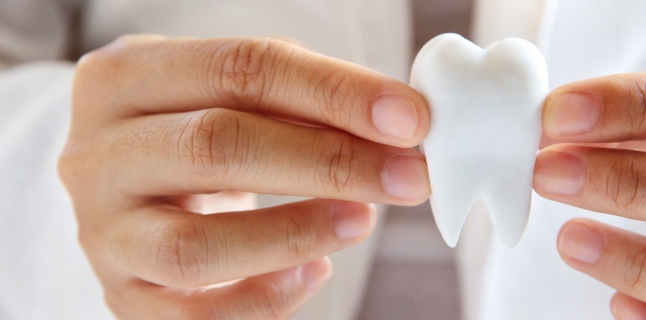Periodontal disease - prophylactic and treatment methods

- certain conditions (puberty, pregnancy, menstruation), - certain medicines (some antidepressants and contraceptives), - vicious habits (), - illnesses . Symptomatology is relatively low initially when it comes to gingivitis. At that stage, as I have already said, only the color changes (intense red turn) and volume (swelling) of the gum, accompanied by bleeding to the touch, and brushing. With the evolution to periodontitis, there are: (bad breath) with teeth root degeneration, purulent secretions in the gum, changes in the position of the teeth, their mobilization, occlusion disorders, and finally the loss of teeth. It consists in the correct and constant hygiene of the entire oral cavity and has two components, both equally important: a) Hygiene of the teeth at home, by the patient. It does by brushing the teeth twice a day, morning and evening.
Increased attention is advised on the retention, interdental spaces that can interfere with dental floss or interdental brush. Rinsing has an antiseptic and anti-inflammatory role. b) Occupational hygiene in the dental office It is recommended to be done at least six months or more often: at four months, at prosthetics and three months in smokers. Professional hygiene aims at removing any traces of bacterial plaque and tartar, leaving smooth and non-adherent surfaces to slow down the deposition of. The first step is to locate bacterial plate deposits with chemical revelators.
It then goes to ultrasonic scaling both supragingival (at the level of prosthetic works) and subgingival (at the level of cement). Unlike mechanical scraping, ultrasonic scrap does not have any harmful effect on the teeth. The only minor disadvantage that may exist is the possible appearance of a slight cold or sweet, sensitivity that disappears a few days after detartration. After scaling, special devices are used that blow a tear-free powder on the surface of the teeth to neutralize acidity caused by microorganisms. Only in the end is professional brushing with specific brushes and pastes.
Depending on the severity of the condition, curative treatment will be of two types: nonsurgical and surgical. An important role in determining the type of treatment is given by radiographs that reveal the degree of bone destruction. a) Non-surgical treatmentConstation, as well as prophylactic, in rigorous hygienic ultrasound and. Applications of antibiotic and anti-inflammatory substances, such as gels, are used in interdental drains. Oral antibiotics may also be given.
Another important step in nonsurgical treatment is polishing dental surfaces (especially interdental). b) Surgical Treatment Choose the right procedure according to the clinical situation: • - it is done only with local anesthesia, with the help of special curettes to clean the volume periodontal area (periodontal pockets). • Flap surgery - Incubates and removes a gingival potion, which allows exposure and cleansing of the dental root; . • Addition of gum - used in extensive gingival stretching and consists of inserting a buccal mucosa, generally from the palate (the mouth of the mouth), instead of the gum removed. • Addition of bone material - it is used in deep periodontal pouches with large bone destruction; .
For those who, for one reason or another, refuses surgery, as the latest technology application, the use of the 940 nm LLL (Low Level Laser) laser capable of destroying only pathogenic bacteria and affected tissues . Specialist advice is recommended in case of the following symptoms: - - bad breath -. All these are signs of gingivitis. Untreated will evolve to periodontal disease. .
Source : sfatulmedicului.ro
Views : 3063
Popular Article
- (photo) Nude becomes art.
Posted: 2018-03-17, 9589 views.
- The harmful effects of air conditioning on the skin
Posted: 2017-06-08, 8269 views.
- 3 causes of dyed hair discoloration
Posted: 2017-06-15, 8142 views.
- Why early puberty occurs in girls: symptoms, favors, diagnosis and treatment
Posted: 2017-10-24, 7999 views.
- Good or bad skin treatments in the hot season
Posted: 2017-06-07, 7737 views.
Recommendations
- (photo) Nude becomes art.
Posted: 2018-03-17, 9589 views.
- The harmful effects of air conditioning on the skin
Posted: 2017-06-08, 8269 views.
- 3 causes of dyed hair discoloration
Posted: 2017-06-15, 8142 views.
- Good or bad skin treatments in the hot season
Posted: 2017-06-07, 7737 views.
- Risks of practicing sports on hot days
Posted: 2017-06-12, 7330 views.
 4 effective ingredients in the fight against acne.
4 effective ingredients in the fight against acne. How to get rid of hiccups fast
How to get rid of hiccups fast The wheat bran diet: the secret of lost pounds as if by magic
The wheat bran diet: the secret of lost pounds as if by magic The recipe that will sweeten your soul this weekend!
The recipe that will sweeten your soul this weekend!  Is it dangerous or not to refreeze meat after thawing it?
Is it dangerous or not to refreeze meat after thawing it?  The unusual sign of diabetes indicated by saliva.
The unusual sign of diabetes indicated by saliva. What to drink to boost your immune system.
What to drink to boost your immune system. 10 foods that help you never age.
10 foods that help you never age. What actually happens in your body if you drink a cup of coffee for breakfast
What actually happens in your body if you drink a cup of coffee for breakfast 5 surprising benefits of chia seeds
5 surprising benefits of chia seeds